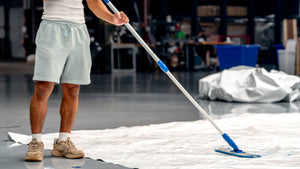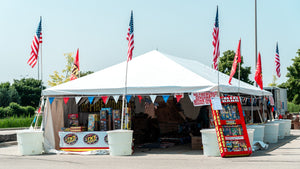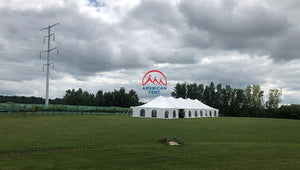When organizing an event, various factors must be taken into account. If it's an outdoor event, you'll probably look into purchasing a commercial grade party event tent. One important aspect is the selection of an appropriate tent, as well as considering costs and size. However, the primary concern should always be safety, as the host is responsible for ensuring the well-being of all attendees. That’s a big responsibility!
As you know, at American Tent we are always eager to learn more about tent safety! As you probably ALSO know, Pete McVey is the absolute authority on this subject for our industry. We met with him recently to chat about best uses and safe practices for our tents here from American Tent. Here’s what he had to say about securing a tent in inclement weather. Keep reading!
What to Know About Weather Conditions When Setting Up a Tent and Using It

Don't fool with mother nature. That's the first rule. Always be aware of your surroundings, be aware of the weather. Tent safety in extreme weather is a serious issue. That's why proper staking is essential. Even if the weather forecast is mild, it is always best to prepare for the worst by staking your tent securely, making sure your tent top is tight, and the tent is properly installed and secured. as if there was a major storm on the horizon. If thunder and lightning make an appearance at your party, seek safe, indoor shelter immediately.
Setting Up a Tent in Snow: What Do We Need to Know?
The most important thing to know is that most tents are not snow load rated. In other words, they will not accept a significant load on the roof of the tent. All American Tents are non-engineered temporary structures. There is no snow rating on any of the American Tents tents and sidewalls.
What that means is you have two options. The first option is to keep the tent heated minimally, between 38-40°, 24/7. If you keep it heated at 40, it's about 70 degrees at the peak of your tent top to help the snow melt off. If you can't afford, don't want to, or don't need to heat your tent, then you're going to be faced with the second option; somebody on watch with a snow rake to rake the snow off of the tent. And, of course, no lawn rakes. Use a snow rake with no tine metal scraping.
How to Protect a Tent In a Thunderstorm and Lightning?
Most events like big music festivals, sporting events, and football stadiums are generally evacuating their event when lightning is within 6 miles of the event location. Anytime you have lightning within your area, whether you're under a high wind tent or out in the open 6 miles away, you need to get to a safe haven. In addition to taking immediate action during a thunderstorm, it is also important to prepare for the possibility of severe weather in advance. This includes checking the forecast before the event, and having a clear plan in place for evacuating the tent in case of an emergency.
How to Set up a Tent in the Wind?
If you’re wondering how to set up a tent in the wind, American Tent has the answers. Additionally, while you may be looking for a high wind party tent, please note that there is no wind rating on any of the American Tents tents and sidewalls.
Fortunately, our industry has been blessed with a lot of studies regarding wind and we've come to the conclusion that when wind speeds reach 35-38 mph, it is essential to evacuate the tent for safety.
It's not only the strength of the wind that is dangerous, but also what the wind can carry. At these wind speeds, items such as outdoor furniture, umbrellas, garbage cans, and portable toilets can be blown around by wind, which is why American Tent recommends this range for evacuation. Although there is no definitive evidence of how much wind a party tent can withstand, weather can change unexpectedly. This is why proper staking and ballasting of the tent is so critical.
You may be wondering how to secure a canopy in the wind. In the event of forecasted high winds, American Tent highly recommends taking down or "dropping" the tent to protect your investment. With frame tents, this can be done by removing the legs and lowering the frame to the ground. Next, remove the tent top from the frame and make sure ratchet straps are secure. This allows wind, heavy rain, hail, and snow to pass through the frame, as it no longer has a surface to add tension.
For peak performance in challenging weather, choose the Ameritrac Keder Tent. Its cutting-edge track system seamlessly guides the tent fabric into the frame. When winds intensify, effortlessly remove the fabric to protect its integrity while keeping your tent frame intact. Discover the ultimate model for durability.
Please note, if there is a risk of falling objects such as trees, it is best to disassemble the entire tent to prevent damage to the frame. Whether you wish to invest in a standard tent size or are looking at tents for big events, you'll want to make sure your tent is installed correctly and that you take safety precautions for unexpected circumstances.
Staking the Tent
Before staking a tent, it is CRITICAL to contact your local utility 811 number and have the site checked prior to staking. They will help locate underground utilities, including electric, gas, oil, steam, telephone, CATV, water, and sewer services. It is also important to consider the following factors when selecting a site:
- Soil conditions that are adequate for anchoring
- A location that is elevated, level, and clear of debris
- Adequate space to anchor the tent around the perimeter
- The surface of the site (grass, gravel, concrete, asphalt, wood)
- Have easy to access emergency exit routes
Drive a stake approximately 5’ away for 7’ legs, 6’ away for 8’ legs, and so on. Stakes should have 6” or less of the head exposed. The deeper the stake is driven, the better the holding strength. Stakes driven vertically have better holding strength than stakes driven at an angle.
Using Weighting and Ballasts

If you’re wondering how to set up a tent in windy conditions and secure it properly, we’re here to help. Securing a tent can be achieved in various ways, such as utilizing concrete or water for ballast. However, when stakes are not an option, the Tent Ballasting System is a reliable alternative. It is a more efficient option compared to using cement blocks or 55-gallon water drums as it is an easy-transport solution for securing your tent.
Should You Take the Tent Sidewalls Off in Heavy Winds?
When heavy winds attend your backyard gathering, you may be debating whether to keep your gazebo open or closed for high winds. The safest thing for the integrity of the attempt is to let the wind blow through. In other words, take the sidewall off. On windy days, when the tent is not in use for an event, it’s always a good idea for the end user or installer to take the sidewalls down. It’s a simple and quick process. This will help improve the longevity of your walls.
You can imagine if you have tables set up with china, linens, and floral, that's probably not too practical so the second option is to make sure that everything is tight and that the sidewall is tight to the ground so that it can't flap. That way it'll allow the wind to hit the sidewall and go up over the tent. But in prolonged wind storms, if you can't take the tent down or abandon the tent - sidewall off, let the wind blow through.
Other Things to Consider When Planning an Event in High Winds
Weather can have disastrous effects on all kinds of structures and tents are no exception. In this article, American Tent’s very own Tent Guru, Pete McVey, who made it his mission to design and provide the best tents possible, gives you a quick look into the effects of weather and mother nature on a tent and shares tips on how to choose the best tent for windy weather.
Effects of Rain on a Tent
When considering the impact of rain on a tent, it is important to understand that water is heavy and not meant to accumulate on top of a tent. When it does, it can cause something known as "ponding." If left unchecked, ponding can result in the collapse of a tent or damage to the fabric due to excessive stretching from the weight of the water.
The ways to eliminate ponding on a tent are numerous, and most of them have to do with proper setup. When we say proper set up, we mean:
- The ratchet straps are tensioned correctly, nice and tight
- The ratchet straps are properly attached to the stake
- The stake is driven at least 36” into the ground
If this is done at all locations around the tent and everything is tensioned correctly, you should end up with a piece of tent top fabric that is perfectly flat and sheds water so there is no way that it can accumulate water. In comparison, a canopy tent for rain and windy weather that lacks the proper tensions and set up will have wrinkles, the fabric will move around, and there will be a space for ponding, increasing the likelihood of damaged fabric and the poles sinking.
Fire Safety
- When you think about tent safety, you most likely think about the weather and what happens to tents in storms. But you also need to consider what happens if there is a fire in a tent?
- Be careful with fireworks. Tents are a popular choice for the holidays like the Fourth of July, Memorial Day, and Labor Day events. Fireworks often make an appearance at these events. Since you want a safety tent, make sure that the tent is a safe distance from where fireworks will be lit.
- Grill safety. A celebration just isn't the same as a good old-fashioned cook-out. After all, few things are tastier than freshly grilled foods. Just make sure that your grill is a safe distance from your tent and you have a fire extinguisher nearby. You also should never leave a lit grill unattended.
- Setting up lighting. If your party is going to extend into evening hours, be sure to think carefully about lighting. If you're planning on using an electrical source, leave the lighting plan up to the experts. Candles provide a beautiful ambiance, but to avoid tent fires, be very careful about placement or opt for battery-operated non-flammable candles
Prepare an Evacuation Plan
For the safety of your guests, include an evacuation plan as part of your event planning. Most safety guidelines generally recommend evacuating when lightning strikes are within six miles of your tent. However, we always recommend that you err on the side of caution. During high winds, the best plan for tent integrity is to remove sidewalls, if any, and let the wind blow straight through the tent. But if you have invested a lot in your decor, make sure everything is sealed up tight to protect your belongings. Regardless of weather conditions, your guests’ safety should be your number one priority.
Preparing an emergency evacuation plan for a commercial grade tent is crucial for ensuring the safety of all attendees in the event of an emergency. We always recommend that you err on the side of caution. Here are some steps to take when creating an emergency evacuation plan for a commercial grade tent:
- Conduct a risk assessment: Identify potential hazards and assess the risks associated with using a commercial grade tent. This can include severe weather conditions, fire, or other emergencies.
- Designate emergency exits: Clearly mark and identify at least two emergency exits for the tent. Make sure that these exits are easily accessible and clearly visible.
- Train staff and attendees: Provide training to all staff and attendees on the emergency evacuation plan, including the location of emergency exits, the sound of the emergency alarm, and the evacuation procedures.
- Have a communication plan: Have a process in place to communicate with attendees and staff in case of an emergency.
- Have a plan for after evacuation: Have a strategy for where to gather after evacuation and how to account for all attendees to ensure everyone's safety.
Conclusion
You want your party to be memorable for all the right reasons. Fire and inclement weather may threaten to ruin your big day, but with proper preparation, you can make sure your event is enjoyable and safe for your guests. As we always say, mother nature can be finicky. At American Tent, safety is our number one priority. Our products are designed to withstand the elements and our experienced, award-winning team is here to help instruct you on the best tips for tent safety. Contact us, buy your custom tents, and be confident that you’re getting the best in quality and service.







